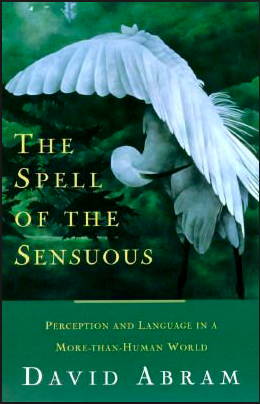The Spell of the Sensuous by David Abrams:

In Abram’s book, he compares our modern society to traditional societies comparing the difference in connection to the nonhuman world. David Abram studies philosophy and cultural ecology and in this book, interweaves the two to make a powerful book showing what is wrong with society today and our relationship we hold with nature/nonhuman world.
David Abrams focuses on societies/peoples’ relationship to nature. He focuses on the early relationships society has created and held focused on a philosophical and ecological mindset. This book allowed me to see the way other societies view culture, social justice, and environmental rhetoric and show that there isn’t one definition for them. There isn’t one way people live life or view it and because of there is variety in the world. Variety is good but in some instances, it would be better if everyone held the same opinion. From reading this book, I believe people should hold the same view of relationship of the human world and the nonhuman word as the small cultures do. If society held this type of relationship to the nonhuman world many of the ecological peoples that are occurring now wouldn’t be as intense and alarming. The questions that arose from this reading have given me inspiration for my food blog. I would like to approach my final project with the same mindset as Abram, philosophically and ecologically.
- What is environmental rhetoric? What is culture? What are the key words/terms/concepts relevant to this research and/or theory?
Environmental rhetoric is how people see or view nature in their daily lives. The environmental rhetoric Abram uses how people think of their relation to nature. In the communities, he studies their close connection to the nonhuman world, whether is being a few individuals or the mindset of all the people. There isn’t a distinct division in the communities and the nonhuman world like is in modern society.
As David Abram stated, culture is “boundaries reinforced by social customs, taboos, and most importantly, the common speech or language” (9). The social customs he focuses on are the magical practices of traditional societies. The culture he chooses to focus on is the cultures of those who hold a deep connection to the nonhuman world. Terms that are relevant to this research are centered around philosophy, cultural ecology and practices related to it. There are multiple terms that are brought up in this book since numerous cultures are discussed and one term my not hold the same meaning in another. Because of this I will give a few basic terms used in the book. A person would not need to know these terms when reading this book however because Abram provides all the information needed to understand the topics being discussed.
Awareness:” a quality that they (indigenous peoples) themselves are inside of, along with the other animals and the plants, the mountains and the clouds” (Abram, 227). (Australia)
Awareness: “the sense of a relatively personal self or psyche” (Abrams, 237). (Navajo)
Synaesthesia:” the overlap and intertwining of the senses” (Abrams, 124).
- What is the rhetorical situation (for this research/narrative)? Which principles and rhetorical approaches are useful to your understanding of environmental issues? How does this book align with the major themes of this course?
The rhetorical situation used in this book is one of reflection and philosophy. Abram makes the reader question their relationship with the nonhuman world as he shows these communities. In his philosophical interpretations of ecology, he draws the reader in and doesn’t make it feel like a lesson but gives a story and along with it questions for the audience to think about.
The book connects with the major themes of this course for how ecological is a part of society and how it affects and determines peoples’ mindset. In those mindsets, it affects their culture around food. Being close to the environmental and all that is included makes people more appreciative and respectful of what they receive from it.
- How does this book address issues of social justice facing vulnerable communities?
While Abram discusses these small communities, he doesn’t fail to mention how they were viewed when first interacting with foreign communities or people. They are portrayed as lesser with a sense of unrealism to them. Abram choosing to show communities with traditions that are not as prevalent or well known in modern society are abnormal and history as shown that society does not like those who are too different from themselves. If these societies do not continue to exist there is a likely chance their culture could be lost from this world.
- What is exigence (motivating issues for this research/narrative)? Who is the intended audience (implied, targeted, unintended; primary, secondary, tertiary)? What is rhetorical agency (intellectual power; economic power; cultural power)?
The motivating issue for this research is for people to be more connected to the nonhuman world. With all the cultures or societies Abram discusses
The intended audience is anyone who desires to study the differences of cultures change a person’s connection to nature
The rhetorical agency in this book is cultural power. Because the way the nonhuman world is incorporated in these community’s life’s they have a richer life. Based on the person’s culture they have a different outlook on life. Culture more in sync to the nonhuman world live life with more meaning so it could be argued they live a better more fulfilling life.
- How does rhetoric shape environmental citizenship (belonging within this intellectual/scholarly sphere of research)?
The ways a person chooses to view environmental citizenship determines how they accomplish that task. In the traditional societies Abram covers, environment is almost entirely interwoven in their society. In contrast, our modern society has lost touch with their environmental citizenship. Through the different styles of rhetoric addressing the environment different meanings can be taken from it and with each approach it appeals to a different type of audience. Since Abram uses a philosophical approach he appeals to those with emotions. And the result is those who will hold an emotional connection with the environment.
- How does this book help you understand the thematic units of this course? Erotics of Food, Aesthetics of Food, Ceremonies of Food, Cultures (Communities) of Food, Cultivation of Food, Distribution of Food
This book helps me to understand thematic units of the course because the way the way a society or person sees the environment around them dictates the importance put on elements in other aspects of life. The way a person views the nonhuman world dictates how they treat everything involved with it. If a person respects the resources the nonhuman world provides more emphasis is put on the rituals and practices for it. Those who respect animals and the process to being able to them are more thankfully for being able to eat and enjoy the meat that specific animal provided.
While reading this book, it was interesting to see the comparisons and the vast similarities throughout different cultures. It was not surprising how Abram discussed that society has moved away being more intertwined with nature. the book made me question how I myself interact and view nature in my daily life. I really loved the book and the lesson I got from it.
Advertisements Share this:





